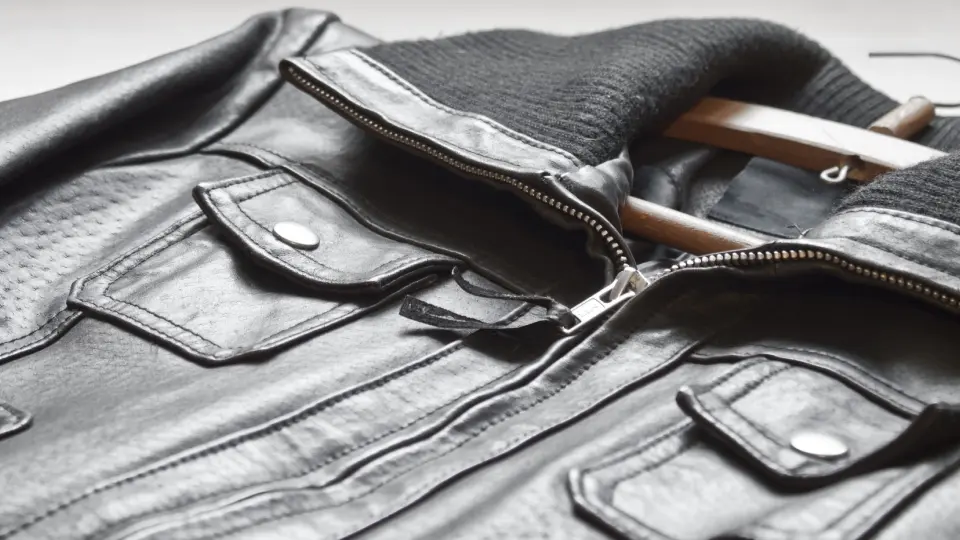How to Iron a Leather Jacket in a Few Simple Steps
Wrinkles and creases are common issues when it comes to leather jackets, whether brand new or used. The main culprits behind these wrinkles are typically poor packaging and storing practices, as well as regular use.
Fortunately, there are several ways to remove wrinkles from leather jackets. Although unconventional, an effective and convenient way to do this is by using an iron. While you should never place an iron directly on leather, there are safe ways to iron your leather articles, using a pressing cloth or a towel.
In this guide, we’ll teach you how to safely iron wrinkles out of your leather jacket, making it look brand new in 6 simple steps!
1. Prepare an Ironing Board or Any Flat Surface
Before you start ironing your leather jacket, you’ll need to find a suitable surface that is flat. While we recommend using an ironing board, as it supports your leather jacket and is designed for the process, you’ll also be able to use any other flat surface.
Suitable flat surfaces include a table, the floor, or even a countertop. Whichever you choose, you’ll need to ensure that it’s clean and smooth, to prevent damaging the soft leather material.
2. Prepare Your Leather Jacket
Start by examining the jacket for any stains or dirt that need removal. Gently clean the surface with a soft cloth or sponge using a suitable leather cleaner. Once the jacket is clean, allow it to air dry completely before proceeding to the next step.
Next, apply a leather conditioner to keep the material soft and supple. Rub a small amount of leather conditioner onto a clean cloth and gently massage it into the jacket in circular motions.
This will help prevent the leather from drying out and becoming stiff during the ironing process. Similar to the cleaning process, we advise that you let your leather jacket dry naturally before ironing.
3. Set the Iron to the Proper Temperature
In addition to having a suitable surface for ironing, there are a few more steps to consider before ironing your leather jacket. First, you need to set your iron to the appropriate temperature.
Important Notice: As leather is a delicate material it can easily get scorched if exposed to direct high heat. Therefore, you should use your iron in a medium setting with no steam. Steam will burn right through the pressing cloth, towel, or kraft paper and will cause permanent damage to your leather jacket.
4. Use a Pressing Cloth, Towel, or Kraft Paper
Next, use a pressing cloth, a thin tower, or some kraft paper and place it on top of the area you wish to iron. Remember that leather is a material that is sensitive to direct heat. By not placing any material between the leather and the iron, you will end up warping, shrinking, discoloring, or even scorching your leather jacket.
Placing a material like a pressing towel in between creates a protective barrier that helps to distribute the heat more evenly on the leather and also helps to absorb any access heat. This simple yet effective method is particularly useful and safe for sensitive materials like leather.
5. Gently Iron in Circular Motions
Before placing your iron on the pressing cloth, towel, or kraft paper, you want to ensure that the leather jacket is completely flat, or else you’ll end up ironing in wrinkles instead. Use one hand to hold the layer and leather jacket in place and the other to move across it with your palm.
Then, place the iron on top of the layer, apply gentle pressure, and move the iron in circular motions. Remember to avoid keeping the iron in one spot for too long, as this can potentially damage the leather.
Move to the next area using the same steps mentioned earlier. Place the pressing cloth on top of the next area, ensure that it’s completely flat, and start ironing out any wrinkles. It’s important that you take your time when ironing your leather jacket and avoid having the iron make contact with it directly.
By continuously moving and repeating this process, you can ensure that all areas of your jacket receive equal attention and care.
6. Hang & Air Dry
When heat is used to iron out wrinkles, moisture may penetrate leather, which can potentially alter its natural oils and fibers, potentially leading to stiffness and discoloration. In some cases, it can even lead to mold and mildew growth.
Therefore, allow it to hang freely to give it enough time for the moisture to evaporate completely. Hanging your leather jacket in an area with good airflow is recommended to speed up the drying process.
However, avoid placing it near any heat sources or in direct sunlight, as this can cause the fibers to become brittle. Patience is key when air drying leather, as rushing the process may result in unwanted creases or wrinkles.
If you notice that the leather is dry, we recommend that you condition it again. Conditioning your leather jacket allows it to maintain its suppleness, prevent drying and cracking, and extend its overall lifespan. Lastly, store it appropriately and provide it with fresh air from time to time.

About Gerrit
Co-Founder, Researcher & Writer At Leatherskill
I’m a leather enthusiast who spends most of his free time crafting, researching, and writing about the many facets of this versatile material. Thanks for reading!

